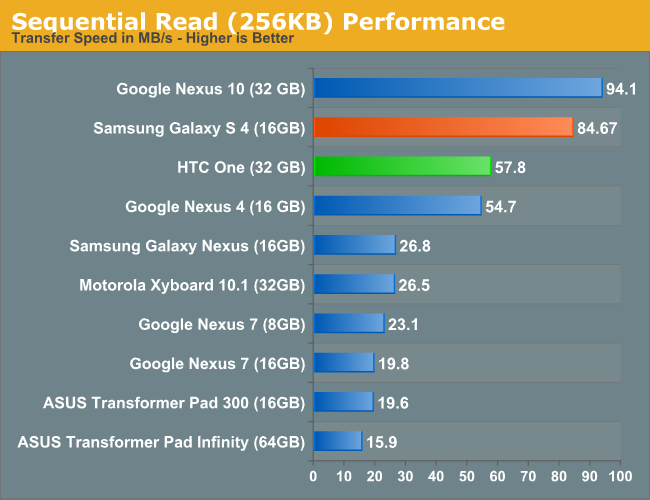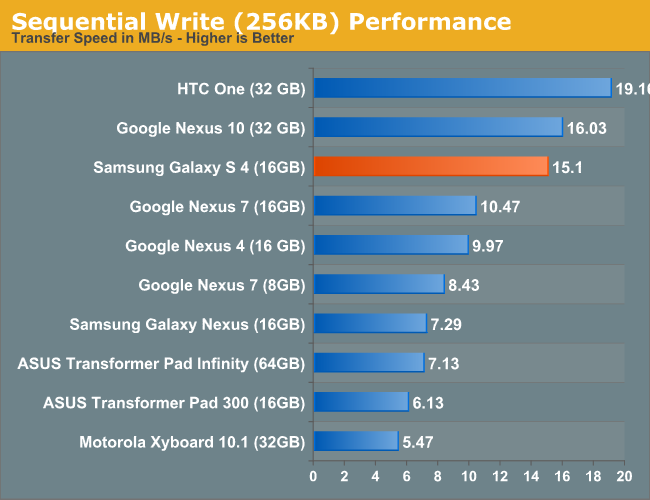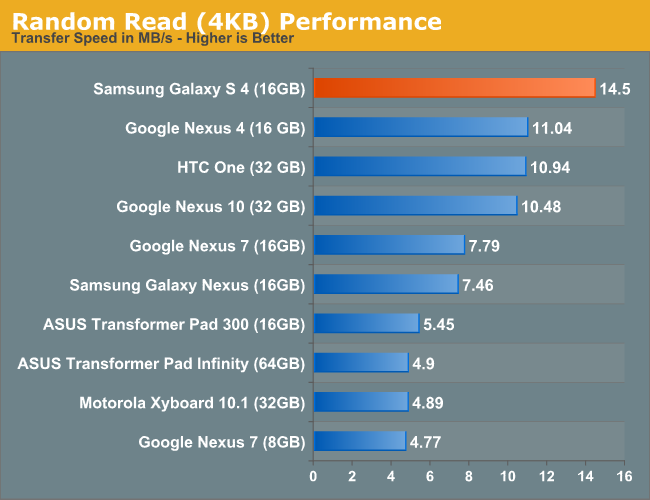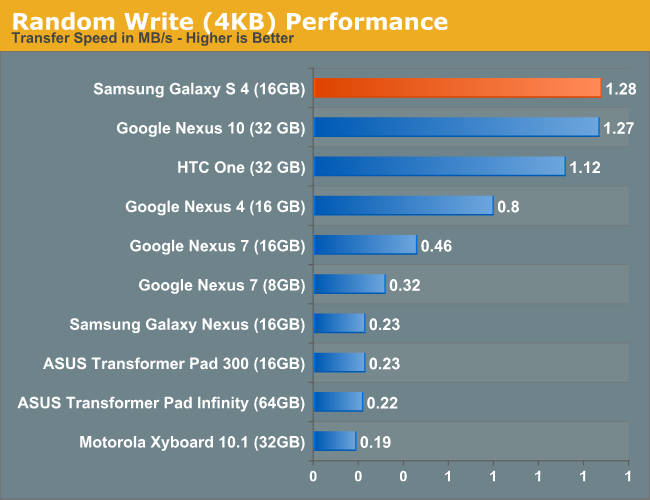Samsung Galaxy S 4 Review - Part 1
by Brian Klug on April 24, 2013 12:01 AM ESTNAND Performance
The Galaxy S 4 ships with either 16GB or 32GB of NAND on-board, but allows for expansion via a microSD card slot. The latter is a quickly disappearing feature on modern smartphones, but it remains a point of differentiation offered by Samsung. We were sampled a 16GB version of the Galaxy S 4, which arrived with 9.62GB of usable space after the OS and app pre-load.
As always we're using Androbench (with modified settings) to quantify NAND performance. Thankfully NAND performance has been steadily improving on modern smartphones/tablets, and the Galaxy S 4 is no exception. Sequential read performance actually sees a tremendous boost compared to most of the other devices in our charts here. Optimizing for sequential read performance makes a lot of sense, but it's good to see Samsung being competitive on all fronts here.
It is worth pointing out that NAND is treated very much as a commodity in these devices, and it's entirely possible that you'll see performance deviate from what we've shown here depending on what controller/NAND/firmware combination you get in your device.














335 Comments
View All Comments
mike55 - Wednesday, April 24, 2013 - link
One of the reasons I am considering the One is because of the camera. 4 MP should be enough for me since I would be viewing it on a 1080p display (2.1 MP) tops. But then I found out the field of view is really large, which would mean I would probably be more likely to crop photos. The images also aren't very impressive in good lightning conditions. It almost looks like it would be a downgrade from my iPhone 4 in terms of photos taken with good lightning. Of course the low light shots would be much better on the One.With the GS4, it feels like the camera is an upgrade in every way, and not just some ways, from my current phone. That, the larger screen, and the fact that the screen is OLED is pushing me towards the GS4. Still conflicted though, haha.
UpSpin - Wednesday, April 24, 2013 - link
I agree, 4MP should be enough, but is the lowest acceptable size. 6MP or maybe 8MP would have been better and safer.The HTC One photos in this review seem to be very blurry and poor compared to the same photos taken for the HTC One review:
http://images.anandtech.com/reviews/gadgets/HTC/HT...
http://images.anandtech.com/reviews/gadgets/Samsun...
I don't know what happened.
The field of view is large, which normally is an advantage, especially indoors. But you're right, outdoors, with the lower resolution it might be an issue.
Regarding OLED: I wrote it in another comment, too. I own a HTC Desire with one of the first OLED screens for smartphones. But also have access to a Galaxy Note with OLED. The colors are stunning, but just false. The max. brightness is poor compared to LCD, so outdoors it becomes more difficult too see the content. OLED consumes more power displaying bright objects (webpages), so much shorter battery life. The sub-pixel size is smaller which shouldn't be an issue any longer at such a high resolution and it also doesn't have pen-tile. The real advantage is that black is almost 100% black which is great :-) The disadvantages however are huge, and while I still like OLED technology and also use simpler OLED displays in my own projects, I think it's just inferior to LCD in smartphones right now. (see this review highlighting some issues). But the screen is larger, another advantage for the S4. Sad that the One has such a huge bezel.
Silellak - Wednesday, April 24, 2013 - link
The difference is likely that the camera was set to default or -1 Sharpness in the original HTC One photo and -2 sharpness in this review.gnx - Wednesday, April 24, 2013 - link
If my memory is correct, the OLED in HTC Desire was from CMI, not Samsung, so I'd think slightly inferior. That said, from all I can gather, AMOLED is still a technology in progress, each generation better than the last, though still with some trade-offs compared to the much more mature LCD. If there is one console, Samsung leads the OLED development, with it's Super AMOLED screens, so if you decide to stick to OLED, at least you know you're getting the best OLED out there with the SGS4.nerd1 - Wednesday, April 24, 2013 - link
4MP is not enough, unless the sensor is Foveon.DroidTomTom - Wednesday, April 24, 2013 - link
Button layout. That is my biggest gripe with the HTC One. The power button should never be on the top. I hated it on my Palm PDAs and on every smartphone I have had since. My Galaxy S has a button layout that just works.creathir - Wednesday, April 24, 2013 - link
Brian, the HTC's audio is flat out amazing.How is the audio on the GS4?
Are you planning on doing audio tests in the future? I know compared to my iPhone 5, the One blows it completely out of the water.
Toss3 - Wednesday, April 24, 2013 - link
Are you talking about headphone performance or external speakers?creathir - Wednesday, April 24, 2013 - link
External speakersscaramoosh - Wednesday, April 24, 2013 - link
How is plastic a downside? It's much better than dented scratched up metal that you'll have to wrap in a plastic case to protect it anyways. Just find it funny how the only two times people see their metal phones is when they buy it and when they sell it, the rest of the time it's in a stupid case. Having to buy a case alone is proof that metal isn't a good material for a phone.I dropped my Nokia, what did I do? Bought a new back cover, replaced it. What will I do with the One if I did the same? Oh, I'm fucked unless I want to pay HTC hundreds to fix it and be without a phone for a month.